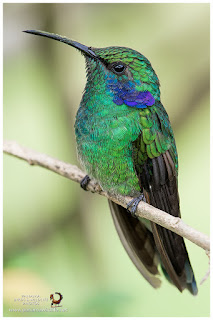 |
| Lesser Violetear (Colibri cyanotus) |
The
Lesser Violetear (Colibri cyanotus), is a medium-sized, metallic green
hummingbird species commonly found in forested areas from Costa Rica to northern South America. This species and the
Mexican Violetear were conspecific and together called the Green Violetear. It breeds from the highlands of Costa Rica and western Panama; mountains of northern Venezuela, and the Andes from western Venezuela to western Bolivia. In Panama it’s
very common in
western highlands, in Chiriquí, Comarca Ngöbe Buglé and Veraguas, and in Azuero peninsula, in forest edge and adjacent clearings.
 |
| Lesser Violetear (Colibri cyanotus) |
Common habitats for the Lesser Violetear is in the canopy and borders of subtropical and lower temperate forest, secondary woodland and scrub, and clearings and gardens in the subtropical zone on both slopes of the Andes. It is recorded mostly between altitudes of 1,200 to 2,300 m (3,900 to 7,500 ft), though they will sometimes wander as far down as 500 m (1,600 ft) in search of food sources. It generally prefers more humid and high-altitude areas, such as
cloud forests.
 |
| Lesser Violetear (Colibri cyanotus) |
Lesser Violetear is a medium sized hummingbird with a black, very slightly curved bill of medium length (for a hummingbird). The plumage primarily is iridescent green, with a broad patch of violet on the side of the head. The rectrices are greenish blue, with a blackish band near the tip.
 |
| Red-tailed Squirrel (Sciurus granatensis) |
 |
| Red-tailed Squirrel (Sciurus granatensis) |
Red-tailed Squirrel (Sciurus granatensis) is a tree squirrel found in Colombia, Costa Rica, Ecuador, Panama, Trinidad and Tobago, and Venezuela.
 |
| Bronzed Cowbird (Molothrus aeneus) |
Bronzed Cowbird (Molothrus aeneus) does not make a nest, but instead lays her eggs in the nests of other bird species.
 |
| White-naped Brushfinch (Atlapetes albinucha) |
White-naped Brushfinch (Atlapetes albinucha) ranges from Mexico to the mountains of Western Colombia. All forms of this brush-finch have a white stripe down the midline of the crown from the forehead to the nape. Above the White-naped Brushfinch is blackish-grey including blackish sides to the head. Below they are variable, always yellow on the throat with the rest of the underparts grayish-white while in some forms the yellow extends throughout the underparts. White-naped Brushfinches are found in subtropical to temperate elevations, from 1,200 to 3,100 m (3,900 to 10,200 ft) in elevation. They forage on the ground, often in family groups. In Central America they may take moist forests with thick undergrowth, in Mexico and Guatemala they may be found in drier Pine-Oak associations, sometimes higher up in cypress forest.
 |
| Slaty Flowerpiercer (Diglossa plumbea) |
Slaty Flowerpiercer (Diglossa plumbea) is endemic to the highlands of Costa Rica and western Panama. This species is characterized by their unique bill shape: the maxilla ends in a long, curved hook, an adaptation used to feed on nectar by piercing the corolla, gaining access to the nectar without pollinating the flower.
 |
| Scintillant Hummingbird (Selasphorus scintilla) - female |
The female Scintillant Hummingbird is entirely responsible for nest building and incubation. She lays two white eggs in her tiny plant-floss cup nest 1–4 m (3-13 ft) high in a scrub. Incubation takes 15–19 days, and fledging another 20–26.
 |
| White-throated Thrush (Turdus assimilis) |
White-throated Thrush (Turdus assimilis) is found from northern Mexico (close to the US border) south to northwest Ecuador; its range encompasses both the Pacific and Caribbean slopes of Middle America. It inhabits a wide range of forest types, but is comparatively rarely seen in the open, usually preferring fairly dense cover. The bird’s plumage is mainly dark brown over the head and upperparts, with paler, slightly buffier brown underparts, becoming whiter posteriorly, with a clean but narrow white band on the foreneck and a heavily dark-streaked throat. As many as 14 different subspecies are recognized within this species.













Comments
Post a Comment